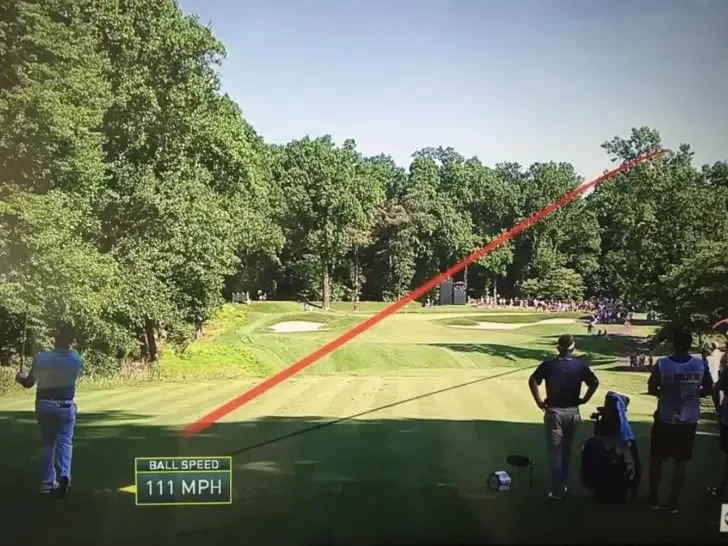A shank in golf is a highly undesirable and often embarrassing shot that occurs when a golfer accidentally makes contact with the ball using the innermost part of the clubface.
Specifically, the ball is struck so close to the heel that it comes into contact with the rounded hosel, which connects the clubhead to the shaft.
In some cases, the golfer misses the clubface entirely and hits the ball directly with the hosel itself.
This is known as a hosel rocket.
This mishit sends the ball shooting fast and low well off course and can happen to golfers of all skill levels.
This particular mishit not only affects the golfer’s shot outcome, but can also be demoralizing and affect their confidence on the course.
And if there is one thing that a golfer needs to play well, it’s confidence in their swing.
What Causes A Shank In Golf?
Swing Path Issues
One of the major causes of shanks in golf is an issue with the swing path.
For instance, an over-the-top swing, also known as an “outside-in” swing, can lead to the heel of the club moving across the target line, often as a result of the hands tossing and flipping the clubhead.
In this case, the heel of the club hits the ball first, causing a shank.
Another problematic swing path occurs when the golfer swings on too much of an inside-out path.
This can lead to the heel of the club getting to the ball first, making it more likely for the hosel to make contact with the ball.
Improper Setup
An improper setup can also contribute to shanks.
A poor address position like standing too close to the ball can cause golfers to lose their spine angle during the downswing, lift out of the shot, and result in a shank.
In addition, if the golfer’s hands, body, or both move closer to the ball during the swing, it increases the likelihood of a shank occurring.
Surprisingly, a shut, or close, clubface at impact is a very common cause of the shanks.
Many people think that because the ball goes right (if your a righty) when you shank it, the clubface must have been open.
While it seems logical, that is usually not the case.
Ensuring a proper setup involves paying attention to the distance between the golfer and the ball, as well as the maintenance of a consistent spine angle throughout the swing.
Mental Effects of a Shank
A shank can have seriously negative consequences on a golfer’s performance and overall game.
There is nothing, I repeat, nothing, that will cause a golfer to lose confidence in his swing faster than hitting a hosel rocket.
Just one shank during a round can completely obliterate a golfer’s confidence and send him down a spiral of swing thoughts and self doubt that will linger until the round is over, if not longer.
The best thing you can do to protect yourself from the deleterious effects of the shanks is to understand why they happen, and how to fix them immediately.
How to Identify Shanks
You’ll know when you hit a shank.
And if you somehow don’t realize it, your buddies will immediately let you know.
A shank is a low-flying, push/slice-looking, terrible-sounding shot.
When trying to identify why it happened, check the following:
- Ball position: Ensure the ball is properly positioned in your stance, as improper ball placement can lead to shanked shots. Standing too close to the ball is a common cause of the shanks.
- Grip: A weak or improper grip can cause the clubface to twist during the swing, increasing the chances of hitting the hosel and resulting in a shank.
- Posture and alignment: Incorrect posture or body alignment can negatively impact your swing path, making it more likely for the hosel to make contact with the ball. An excessively outside in (or inside out) path can cause the shanks.
- Weight distribution: Proper weight distribution throughout the swing can help maintain balance, reducing the chances of shanks occurring. Weight too far forward at impact can lead to a shank.
If the shanks continue, the best way to identify why it is happening is to video yourself in slo-mo.
This will make it very easy to see if it’s your swing path, clubface, or a weight shift that is the primary cause of your shanks.
It’s also important to identify what your most common cause of the shanks is.
When I shank it, it’s usually because I was either standing too close to the ball, or swinging too much from the inside.
Preventing and Correcting Shanks
Here are two great videos on how to fix the shanks:
How To Stop Shanking It
Why Am I Shanking My Wedges?
When to Seek Professional Help
If it’s been a few weeks, you’ve watched all the YouTube videos you can, and you still can’t rid yourself of the shanks, it might be time to get some help from a PGA Professional.
There are numerous potential causes of the shanks and working with a professional golf instructor can help identify and correct such issues.
A PGA Professional will then be able to give you personalized drills to correct your shanks much fasters.


